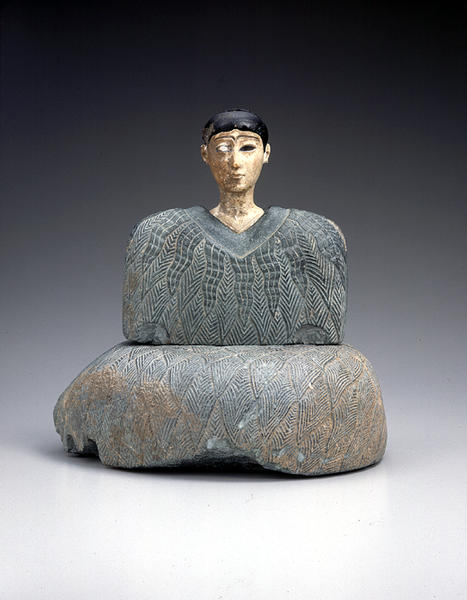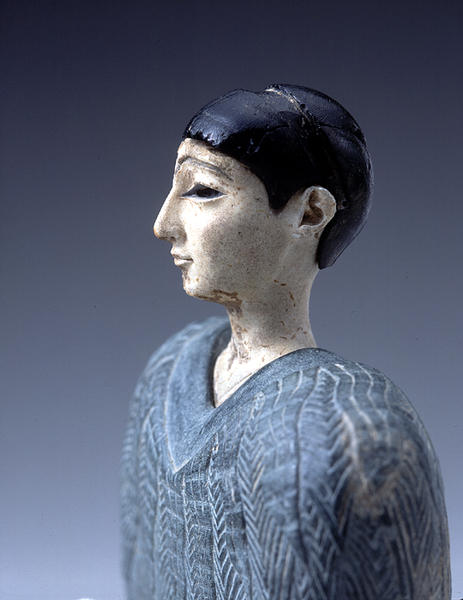女神像
- 前三千年紀後期-前二千年紀初期
- 緑泥岩、石灰岩、瀝青
- H-22.5 D-16.5 W-22
解説(古代バクトリア遺宝展)
前三千年紀後期―前二千年紀初期
緑泥岩、石灰岩、瀝青
高22.5 cm 幅22.0 cm 奥行16.5 cm
この羊毛の房がつけられた衣装をまとう姿の石製婦人坐像の様式は西中央アジアに特有なもので、緑泥岩製の体躯、鮮やかな対比を見せる白い石灰岩の端正な頸と顔面、そして漆黒の髪を表現した瀝青の頭部が印象的である。最近の発見ではナマーズガ文化の栄えたマルギアナ地方から同類の彫刻の断片が出土したことが知られている。同地域はエラム文化の影響を強く受けていたと考えられ、ゴヌール・デペからは原エラム文字の刻まれた陶片のほか、婦人坐像の意匠の銀製ピンが見つかっているが、これはペルセポリス由来で前三千年紀末エラムのものとされる銀製壺に刻まれている婦人像に大変近いものである。本作品はこの一連の婦人像の流れの中にあると考えられ、羊毛の衣服表現、丸い襟ぐり、大きく見開かれた紡錘形の眼など多くの共通点をもっている。エラムの銀製壺の婦人坐像は裸足の足先をみせていることから、本作品の腰右下部にあけられた二つの矩形の穴には足先が取り付けられていたと想像される。同壺には原エラム文字で豊穣と戦いの神キリリサの姉妹神ナルンデの名前が刻まれているが、本作品はこの大地母神系の女神を表したものだった可能性がある。顔面には裏刳りがなされ、左側の眼は今は失われているものの、右側の眼窩に嵌めこまれた眼が裏から瀝青でとめられている。この構造はメソポタミアの人物像とも共通するものがあり、この種の東イラン、西中央アジア地域由来の像の中で群を抜いて完成度の高いものである。
Catalogue Entry
Late 3rd‐early 2nd millennium B.C.
Chlorite, limestone, bitumen
H. 22.5 cm, W. 22.0 cm, Depth 16.5 cm
This stone image of a seated female wrapped in a garment with attached wool clumps is a specifically western Central Asian figural type. The body is made of chlorite, while the regularly formed face and neck are carved from contrasting white limestone and the light black hair and rest of the head is carved from bitumen. A fragment of a similar sculpture has been recently excavated from the Margiana region, site of the flourishing Nanazga culture. It is thought that this region was also heavily influenced by the Elamite culture, and we can see fragments of pottery with proto-Elamite script inscriptions from Gonur Tepe and silver pin with designs of seated women. This figure is extremely close to an image of a woman incised on a silver vase that is thought to come from Persepolis and to be an Elamite work from the end of the 3rd millennium.
If we consider this sculpture in this sequence of female images, we can see that the wool garment expression, the rounded collar, and the wide open, spindle-shaped eyes are all points in common with the other works. The image of the seated woman on the Elamite silver jar shows the ends of her bare feet, which means we can imagine that the two rectangular holes at her lower right hip could have been used for the attachment of feet. The silver jar is also inscribed with a proto-Elamite script text which lists the name of Narunde, the sister goddess of the god of war and fertility Kiririsa, and it is possible that the present sculpture is an image of a goddess from this earth mother goddess lineage. The face has been carved in from the back, and while something is missing from the left eye, the right eye has an inset pupil which is held in from the back by the bitumen. While this formation method can also be seen in figural images from Mesopotamia, this work shows a higher degree of finish that sets it above the other works of this type from eastern Iran and western Central Asia.

